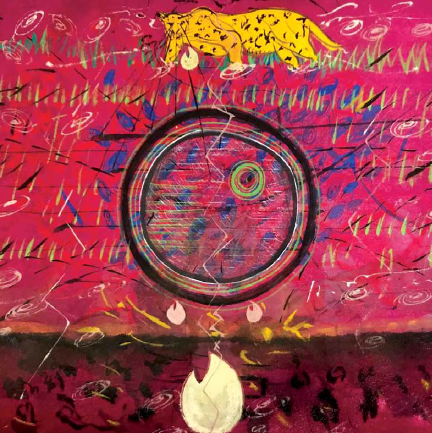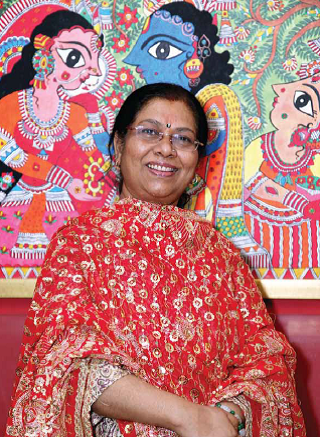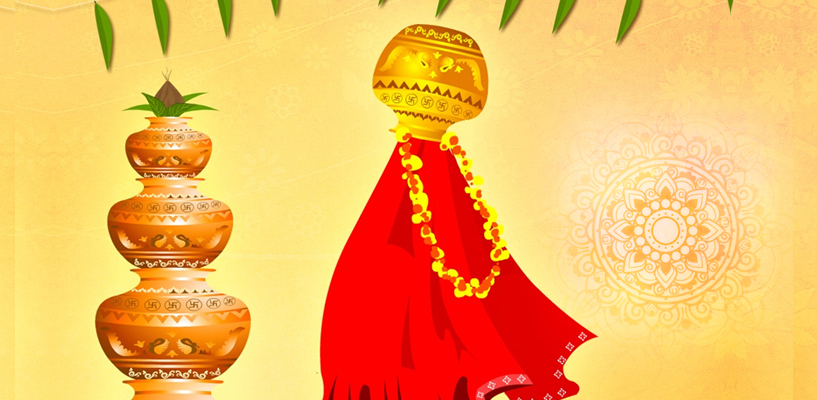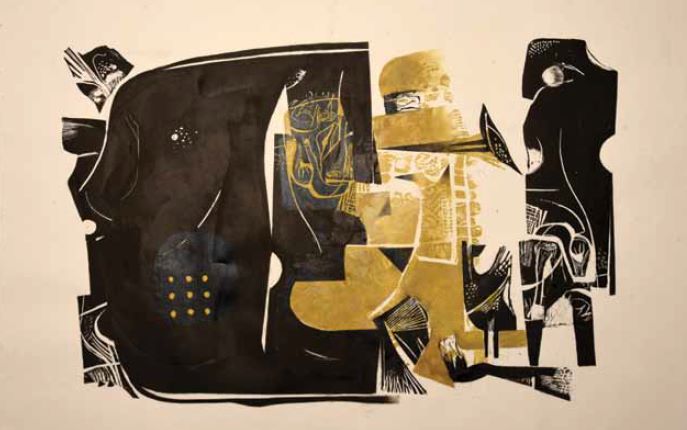
I paint the way I live. My biggest of inspiration is everyday life, of which I am trying to capture the essence.
Art is not just about aesthetics and beauty; it is also about the ability to visually express a thought-provoking story that allows a person to get lost in the delicate maze of brush strokes and paint. Creating such awe-inspiring works of art is not an easy skill, even for the masters. Only a few are able to achieve this level of artistry and one such artist is Fawad Tamkanat.
Fawad Tamkanat was born in 1962 in the city of Hyderabad in western India. His interest in art made him pursue art from the early stages of his life. He started on his journey at a time when art was not well appreciated and popular on curriculum level. A gold medallist in both BFA at JNTU and MFA at the University of Hyderabad, he never let anything get in the way of his curiosity even in his college days.
His endless love for art led him to mould the last four decades of his career into becoming one of the most prominent artists in the art world. Not only did he conduct solo exhibitions across India, but he also exhibited his works around the Internationally. Fawad Tamkanat’s art has a significance and style that instantly lets a person recognize his work. Because of his incredible artistry, he was able to travel across the world, where people were able to experience his art among his 100 plus art shows, 64 exclusive group exhibits, and 30 invited art show participations. Each show was the talk of the town, including a group exhibition curated by Jaya Bachchan and Sapna Kher for Amitabh Bachchan’s birthday. Fawad has always experimented with different styles and constantly searches for opportunities to go beyond canvas. Fawad’s works are museums and collectors’ delight. They hold a place of pride in the famous National Gallery of Modern Art in New Delhi, the Ambani’s and many others. Fawad’s most recent collaboration with art collector and art connoisseur Utkarsh Veer is the highly acclaimed, commissioned art piece titled “Cityscapes,” an exquisite work done on solid teak wood weighing 60 kgs now in the private collection of Utkarsh Veer.
One of the artworks Fawad cherishes forever is, “It’s a Way of Life,” where he got to share a stage with his daughter, Afza Tamkanat who herself is a renowned artist. While Afza’s work is more subtle with delicate hues; father and daughter have their own diverse approaches to art.
Something that has always been a part of Fawad’s journey, is supporting the many not for profit foundations through his shows. Fawad says, “Every year I curate 2-3 charity shows with organisers and donate artworks worth up to Rs 15 lakhs. Mostly, I work for the girl child as many people don’t take care of children, especially if it is a girl child in India, which is sad. I raise funds through my art for education, better living, and scholarships for higher studies, so we have to work in this particular area, and that’s why I am concentrating on camps and offering help during natural calamities in the city and abroad”.
Fawad also reveals his passion for wildlife in his works. One such instance, where he has shared his love for wildlife is through his exhibit “Celebrating Tigers of India,” where more than 70 artists got to exhibit their artwork supporting the cause. This magnificent exhibit in Mumbai was a wonderful hit with the attendance of special guests such as Nita Ambani.


Art Soul Life in a no-holds-barred interview with the artist Fawad Tamkanat, whose themes fluctuate between his inspirations and explorations.
Q. We hear that “everyday life is the main source of inspiration for your narrative paintings”. Could you please elaborate upon it?
I paint the way I live. My biggest source of inspiration is everyday life, of which I am trying to capture the essence. Every morning, I witness the vibrant chaos of urban existence on my way to the studio. Commercial malls with extravagant window display cast reflections of the lively street life, creating a dynamic narrative. The composition invites viewers to connect with the universal aspects of everyday life, fostering an appreciation for the meaningful moments we often overlook.
Q. Your cityscapes inspired by Hyderabad often have structures that are crowded and archaic. In the past couple of decades or so, Hyderabad cityscapé has witnessed modern architecture mushrooming everywhere. Has this affected your work in any way?
Does this affect your “Everyday life nostalgia?” My current series of cityscapes are a tribute to the various towns in India, the Netherlands, Paris and the Middle East. I am hugely drawn to these charming towns that have their own quaint characters. The environment, the people and their cultures move me to paint the silent grace that is embedded in such spaces. Therefore, my narratives are an amalgamation of these spaces that are like reference from my memories. Each corner of my painting is a personal tale that I recreate in my own signature style.
Q. Could you tell our viewers about the rickshawwallah who figures in many of your cityscapes? How did he manage to capture your fancy?
I painted one particular rickshaw-wallah several times because of his aesthetic sensibilities and very calm and composed artistic facial expressions. The way he carries himself in a cotton kurta and indigo lungi is very impressive. Whenever I used to go to the old city to make sketches, my eyes would search for him in lanes and bylanes of the old city.


Q. Afza, your daughter paints too; do you influence and critique each other’s works? Do you have separate ateliers? Please tell us more about the exhibition “It’s a way of life”.
Afza, my daughter is a strong individual, and as an artist, she has her individual style right from her college days. We both have our own atelier. We work separately. After her marriage she settled down in Australia with her husband and two daughters. She paints and exhibits in all major art fairs like Singapore, New York, Australia and reputed Indian art galleries. We often discuss work as she is my biggest critic and I always respect her opinion and I feel very proud to be her father. Last year Gallery Time and Space invited us to exhibit our works as a father and daughter duo. It was a wonderful experience as it was the first for us. We had an amazing response from colleagues and art lovers.
Q. In some of his works, your father, the late Shaz Tamkanat, renowned Urdu shayar and poet, dwelled upon nostalgia (Mujhe yaad padta hai ek umr gujri..), has this influenced some of your works?
My father was a very renowned Urdu poet. He was a guiding light in my life. He has woven the thread of poetry and paternal wisdom into the fabric of my existence. My father and mother always gave us freedom to pursue whatever profession we wanted. We were born in an artistic environment and music; poetry and painting were part of our lives. We used to have sham-e-ghazal (musical night) at home every month. Renowned singer writers and poets like Begum Akhter, Jan Nisar Akhtar, Majrooh Sultanpuri, Javed Akhtar, Kaifi Azmi and many more used to visit our home… We got the opportunity to listen to them very often.
Q. There was a time when you painted black and white erotica and nudes. How did that happen, did you have a muse then?
I painted nudes, erotic dry points and etchings during my residency in Kirsten Kjærs Museum in Denmark. It was when I was travelling very often to Scandinavian countries to attend installation art camps “Tide96” and my solo shows in Denmark, Germany, Sweden and neighbouring countries that I was inspired to do these works as I visited several museums to see works of Van Gogh, Picasso, Matisse and Gauguin. My erotic dry point has a strong influence of Picasso.
Q. There was a time when you painted for eight to ten hours a day. Has this changed over the years?
I still paint very long hours alone when I have peace of mind, particularly if the weather is beautiful and it’s raining or very calm and quiet nights always help me to paint large canvases.
Q. About artists you draw inspirations from, or have been influenced by..
I always keep my eyes open and my mind aware, which helps me to grasp knowledge from various sources. My inspiration is life and life are beautiful. I want to capture the essence of life through my work.
Q. You are known to work on diverse media, experimenting with forms, textures and techniques. How do you choose the medium, style, and technique for your narrative paintings? Is there a method to it?
As an artist I always try to explore new mediums to experiment. I don’t like to paint one subject or one medium throughout life as a rubber stamp like many artists do. Earlier, I used to paint oils and then I switched to acrylic. For many years I worked in black and white only. Life is so beautiful. There is so much to learn and experience every day as an artist. My travelling experience enabled me to learn new techniques and new medium and different surfaces to paint.
Q. Do tell us more about the fund raiser you organized during the pandemic.
I love to curate shows once in two or three years for a social cause and try to invite the most promising artists from all over India and abroad. It has helped me to connect with new and prominent artists and bring them under one roof.
Q. What are some of the challenges and opportunities of being a narrative style painter in the contemporary art world?
There are a lot of challenges and at the same time, great opportunities for every artist if he or she is honest about work. When I was very young, I used to go to very reputed galleries with confidence along with my portfolio. I faced a lot of challenges during my early years, but I was sure that I’m going to work only with reputed galleries and managed to do that. Today, you can see my work at the National Gallery of Modern Art. These paintings are black and white with dry points and etchings. I have more than 100 solo shows worldwide successfully.
Q. Any words of wisdom for budding painters?
Let your passion guide your creativity. Remember growth often comes from pushing boundaries and learning from both success and setback. Experiment fearlessly.









 " >
" >
 " >
" >